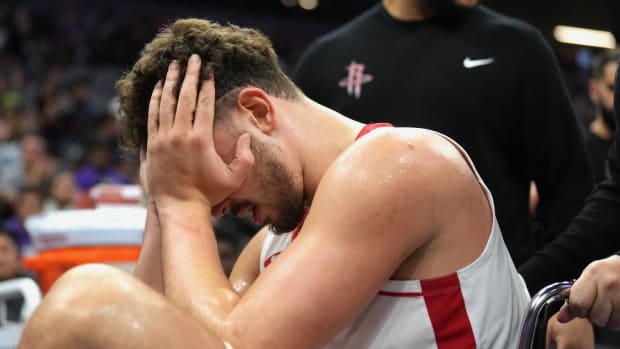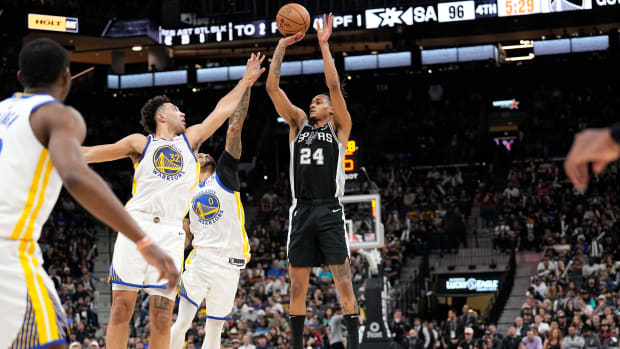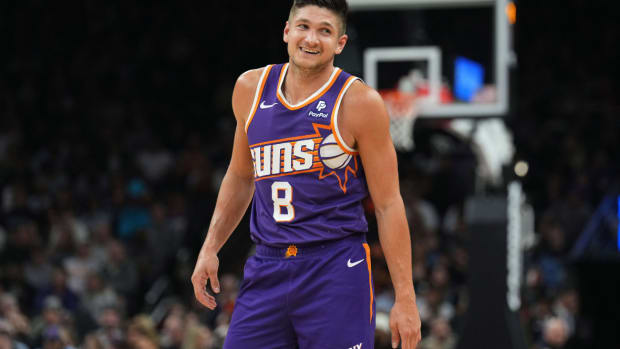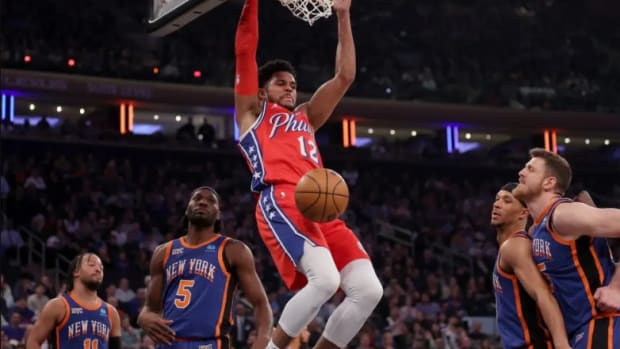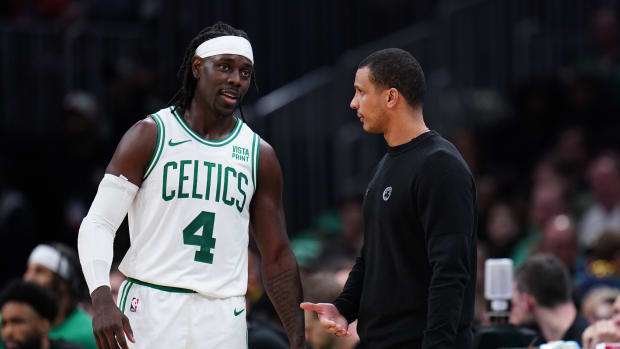Stephen Curry’s knee injury: What it means for Warriors and rest of NBA
Get all of Ben Golliver’s columns as soon as they’re published. Download the new Sports Illustrated app (iOS or Android) and personalize your experience by following your favorite teams and SI writers.
Thanks to a wet spot on the Toyota Center court, the NBA playoffs now hinge on four unsettling words: Stephen Curry knee injury.
The reigning MVP returned to the court for the Warriors on Sunday after missing two games with a right ankle injury, only to see his night end early when he sustained a right knee sprain while slipping awkwardly just before halftime. Although Golden State went on to beat Houston 121–94 for a 3–1 series lead, Curry wasn’t able to return to the court in the second half and could miss two weeks.
• MORE NBA:Warriors’ title defense takes hit with absence of Stephen Curry
Clearly, the implications are massive for the 73-win Warriors, who are looking to repeat as champions. Curry’s value is monstrous and indisputable: he led the league in scoring, threes, steals, Player Efficiency Rating, True Shooting %, Win Shares and Real Plus Minus, and he’s the overwhelming favorite to be named MVP for the second straight year.
What’s known?
Curry sprained his right knee while attempting to defend a Trevor Ariza three-pointer just before halftime. Curry’s left foot appeared to slip on the court first, causing him to lose his balance. With his right foot unable to plant, Curry’s leg twisted awkwardly at the knee as he fell forward to the court. Curry grabbed at his knee immediately before picking himself up and limping off the court.
After halftime, Curry attempted to go through a warmup routine but then retreated to the locker room, holding his head in apparent frustration.
The Warriors announced that Curry could miss two weeks for the injury after he underwent an MRI on Monday. Nevertheless, the initial reaction suggested that Curry’s absence during the second half was more than a simple precaution.
Warriors forward Draymond Green told ESPN Radio after the game that Curry was “crying” in the huddle when the decision was made to sit him out. Meanwhile, coach Steve Kerr told reporters during his postgame press conference, “He still wanted to play. We wouldn’t let him. ... He was very upset. I feel awful for him.”
Curry, who finished with six points (on 2-of-9 shooting), four assists and five turnovers, didn’t elaborate much in his assessment of a forgettable afternoon. “I slipped, I fell, I hurt,” he said, according to the San Francisco Chronicle. “My team is awesome. The end.”
What’s rumored?
A Bay Area television station apparently reported, citing a Warriors team doctor, that Curry suffered a sprained MCL.
InStreetClothes.com, a sports injury tracking website, also speculated on Twitter that Curry might have sustained an MCL sprain, which are categorized as Grade I, II, or III. The website further reported that at least 11 players suffered MCL sprains this season, with the lower-grade injuries keeping players sidelined for an average of 7.2 games over 15 days.
• MORE NBA:Green dismisses reporter for question about Houston’s floods
The higher the grade, the longer the anticipated absence. One high-profile point of comparison: Rudy Gobert was diagnosed with a Grade II MCL sprain on Dec. 2 and the Jazz center did not return to the court until Jan. 7, missing 18 games. Gobert’s timeline was slightly better than average for Grade II sprains, according to the website.
What’s next?
There are some key dates to keep in mind now that Curry has underwent an MRI.
The Warriors will have their first chance to close out the Rockets in Game 5 at Oracle Arena on Wednesday. Given Houston’s lackluster second-half play in Game 4, the most likely scenario is that Golden State wraps its series on Wednesday and turns its attention to the second round.
The Warriors’ second-round opponent will be either the Clippers or the Blazers. L.A. currently holds a 2–1 series lead with Game 4 set for Portland on Monday and a possible close-out Game 5 set for L.A. on Wednesday.
The second round of the playoffs is set to begin on May 2, although it can be moved up a day or two if those series wrap early. Similarly, the conference finals are set to begin on May 17, but could be moved up a day or two. Finally, the Finals are set to commence on June 2.
Here’s how many days Curry will have before each round:
Days until second round begins: 6–8 days
Days until conference finals begins: 21–23 days
Days until Finals begins: 38 days
So, assuming Curry misses about two weeks, the Warriors star could be expected to miss a solid chunk of the second round.
What’s the impact?
Kerr isn’t left completely empty-handed without Curry: Shaun Livingston stepped into a starting role when Curry missed Games 2 and 3 against the Rockets, Ian Clark and Leandro Barbosa are capable of giving minutes off the bench, and Draymond Green and Andre Iguodala are proven distributors. Golden State responded to Curry’s absence beautifully in Game 4, outscoring Houston 65–38 in the second half on the road.
That said, much tougher tests await, in the form of the Clippers (most likely) and the Spurs or Thunder.
This year, the Warriors went 4–0 against the Clippers, 3–1 against the Spurs and 3–0 against the Thunder, but Curry played in all 11 games. This chart breaks down how the Warriors have played with and without Curry this season and how they have fared against each of those three opponents with him on and off the court.
The good news for the Warriors is that they have positive net ratings against the Clippers, Spurs and Thunder when Curry has been on the bench this season. The bad news, though, is Curry’s absence robs Kerr of both his preferred starting lineup (Curry, Klay Thompson, Harrison Barnes, Green, Andrew Bogut) and his best closing lineup (Curry, Thompson, Iguodala, Barnes and Green), forcing one of his reserves to step in against the opposition’s best groups and stretching his second-unit depth.
Indeed, late-game execution will be the biggest thing to watch during Curry’s absence, as he led multiple fourth-quarter comebacks against the Clippers, hit the “Shot of the Year” to beat the Thunder and serves as the focal point of the Warriors’ deadly high pick-and-roll approach with Green. Not only does an injured Curry make it more difficult for the Warriors to run away from elite opponents early in games, it will make closing out playoff games that much more difficult, particularly on the road.
For the Clippers, who still need to finish off the Blazers, this is a gift from the heavens. Golden State has absolutely dominated L.A. during the Kerr era and now, assuming Curry misses at least a portion of the series, the matchup is much closer to even.
Going one step further, the Spurs and Cavaliers now look like favorites in a series against the Curry-less Warriors, given that both looked impressive in their first-round sweeps, both boast A-list talent with experienced cores and both currently enjoy excellent health. The Thunder, whose 2013 postseason run was cut short due to a Russell Westbrook knee injury, would find their most glaring issues—a defense that’s not quite elite, a number of inexperienced supporting pieces, and a predictable approach during crunch time—a lot more manageable against a Warriors team without its best player.































